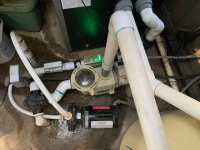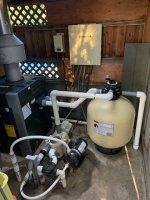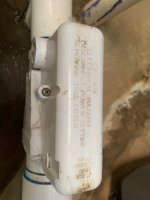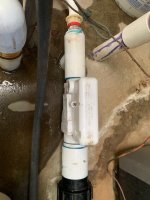There's a few things I'm not sure I understand about my pool plumbing:
1) Why is the discharge pipe 2" from the filter through the heater then the SWG, but drop to 1" Polaris reinforced hose after that, only to go back up to 1.5" PVC at the return to pool?
2) The intake pipe has a 90º elbow, but the discharge pipe has 2 45's. Would it be better to change the intake to 45's (e.g. better efficiency or filter performance)?
3) Can I place unions on the intake pipe and backwash pipe (there's already one on the discharge at the heater) as a good way to be able to remove the multiport for deep cleaning of my sand filter? Do they need to be in the same plane or can one be on the vertical run?
4) What is the white rectangular thing between my SWG and the booster pump? Is it part of the SWG?
5) What do you call the black valve that controls the mix coming from the pool drain and the pool strainer? How do I want to use it? If I need to lower the pool water (my CYA is too high, and my calcium is too high, so I might have to replace a bunch of water ) I assume I set it to 100% through the drain, but why would I use any of the other settings besides 50-50?
6) I have a leaky and shot booster pump. I will either replace or bypass it (moving to robot from pressure side cleaner). If I bypass it, do I need new reinforced pipe, or can I just attach the existing pipe section currently attached to the booster directly to the PVC leading to the pool return? Would it be better to eliminate the 1" and keep a bigger diameter path to the pool?
Any words of warning for a DIY'er before I undertake any of this? Is it much different from working on sprinkler PVC? Is it notoriously hard to line up the unions, for example?
Many thanks,
Bill
1) Why is the discharge pipe 2" from the filter through the heater then the SWG, but drop to 1" Polaris reinforced hose after that, only to go back up to 1.5" PVC at the return to pool?
2) The intake pipe has a 90º elbow, but the discharge pipe has 2 45's. Would it be better to change the intake to 45's (e.g. better efficiency or filter performance)?
3) Can I place unions on the intake pipe and backwash pipe (there's already one on the discharge at the heater) as a good way to be able to remove the multiport for deep cleaning of my sand filter? Do they need to be in the same plane or can one be on the vertical run?
4) What is the white rectangular thing between my SWG and the booster pump? Is it part of the SWG?
5) What do you call the black valve that controls the mix coming from the pool drain and the pool strainer? How do I want to use it? If I need to lower the pool water (my CYA is too high, and my calcium is too high, so I might have to replace a bunch of water ) I assume I set it to 100% through the drain, but why would I use any of the other settings besides 50-50?
6) I have a leaky and shot booster pump. I will either replace or bypass it (moving to robot from pressure side cleaner). If I bypass it, do I need new reinforced pipe, or can I just attach the existing pipe section currently attached to the booster directly to the PVC leading to the pool return? Would it be better to eliminate the 1" and keep a bigger diameter path to the pool?
Any words of warning for a DIY'er before I undertake any of this? Is it much different from working on sprinkler PVC? Is it notoriously hard to line up the unions, for example?
Many thanks,
Bill





